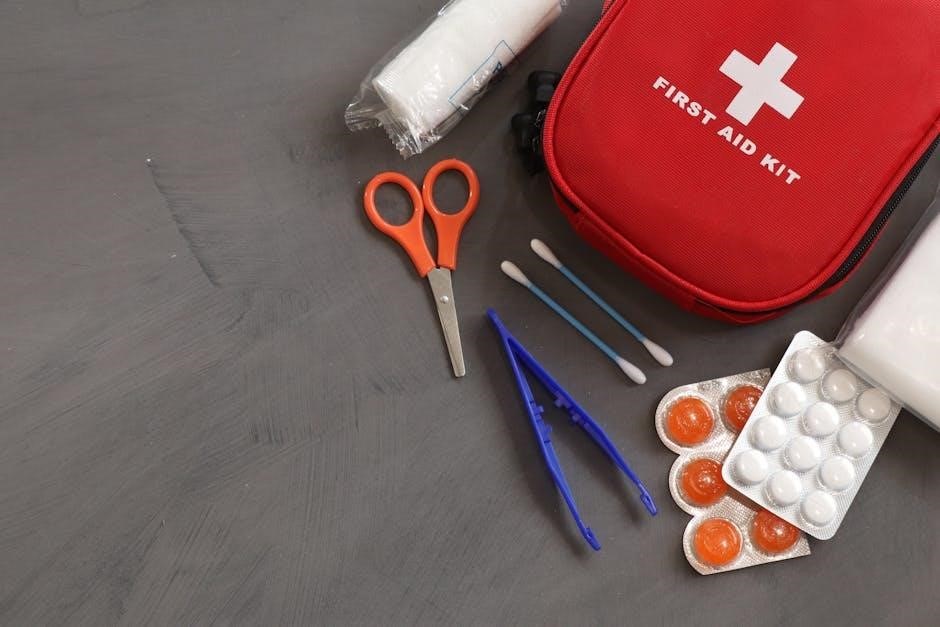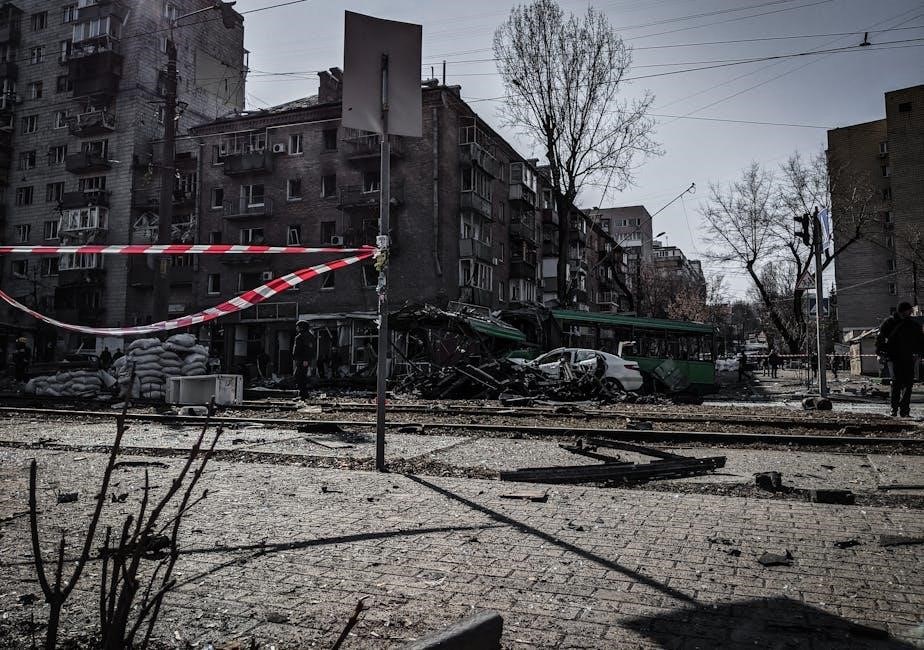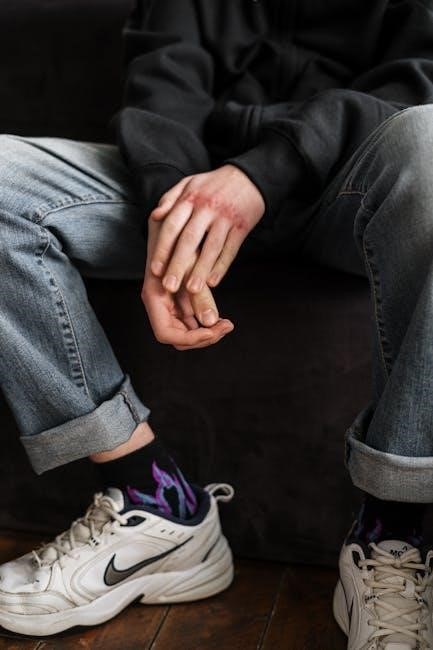Trauma kits are essential for emergency situations, containing various medical supplies, including tourniquets and hemostatic agents, to treat injuries, and can be customized based on specific needs and situations always online.
Trauma Kit Content List
A trauma kit content list typically includes a variety of medical supplies, such as tourniquets, hemostatic agents, gauze, and dressings, to treat different types of injuries. The list may also include items like splinting materials, tweezers, and burn care supplies. According to online resources, a basic EDC kit should include a minimum of supplies to treat gunshot wounds to extremities, while a larger EDC backpack kit can handle more severe injuries, such as abdominal wounds. The list of contents may vary depending on the specific needs and situation, and it is recommended to take a TECC class to learn how to use the trauma kit components effectively. A downloadable PDF checklist can be used to customize the kit based on individual needs. The list should be comprehensive and include all necessary items to provide adequate care in emergency situations. Online resources provide a detailed list of trauma kit contents, including quantities and types of supplies. The list is essential for creating a well-stocked trauma kit.
Types of Trauma Kits
There are various types of trauma kits available, each designed to meet specific needs and situations. Online resources categorize trauma kits into different types, including basic, intermediate, and advanced kits. The type of kit required depends on the level of care needed, the number of potential victims, and the environment in which the kit will be used; Some kits are designed for personal use, while others are intended for use in emergency response situations. The Internet provides information on the different types of trauma kits, including their contents and recommended uses. A trauma kit list PDF can be downloaded to help individuals determine which type of kit is best for their needs. The various types of trauma kits are designed to provide effective care in emergency situations, and selecting the right type of kit is crucial. The Internet offers a range of resources to help individuals choose the right type of trauma kit. Different types of kits are available for different situations.

Trauma Kit Configurations
Trauma kit configurations vary depending on the situation and needs, with online resources providing guidance on customization and downloadable PDF checklists always available for reference online easily.
Basic EDC Kits
Basic EDC kits are designed for everyday carry and minor injuries, typically including essential items such as bandages, antiseptic wipes, and pain relievers, with some kits also containing basic medical tools like tweezers and scissors.
These kits are often compact and lightweight, making them easy to carry in a pocket or bag, and are suitable for treating minor wounds and injuries.
Online resources provide guidance on building a basic EDC kit, including downloadable PDF checklists and recommendations for customization based on individual needs and situations.
Some basic EDC kits may also include items like tourniquets and hemostatic agents, which can be used to treat more serious injuries, and can be a good starting point for those looking to build a more comprehensive trauma kit.
Overall, basic EDC kits are an important part of being prepared for emergencies and can help to provide effective treatment for minor injuries, with online resources available to help individuals build and customize their own kits.
These kits can be easily obtained online or in outdoor stores, and can be a valuable addition to any emergency preparedness plan, with many online retailers offering pre-made kits or individual components for customization.
Extensive Military-Grade Supplies
Extensive military-grade supplies are designed for severe trauma and include advanced medical equipment, such as IV fluids, saline, and giving sets, as well as diagnostic tools like glucometers and thermometers.
These supplies are typically used by trained medical professionals in emergency situations, and are often included in larger trauma kits or backpacks.
Online resources provide guidance on building a comprehensive trauma kit with military-grade supplies, including downloadable PDF checklists and recommendations for customization based on specific needs and situations.
Some extensive military-grade supplies may also include items like obstetric kits, stethoscopes, and neonatal BVMs, which can be used to treat a range of serious injuries and conditions.
These supplies can be obtained online or through specialized medical retailers, and can be a valuable addition to any emergency preparedness plan, particularly for those who work in high-risk professions or live in areas with limited medical resources.
The use of these supplies requires proper training and expertise to ensure effective treatment and minimize harm.

Active Shooter Response Trauma Kit
Active shooter response kits contain multiple tourniquets and hemostatic agents for treating gunshot wounds always online quickly.
Kit Contents
The active shooter response trauma kit contains essential medical supplies, including four North American Rescue Gen 7 CAT Tourniquets, IV fluids, and saline solutions.
These kits also include giving sets, IV canulas, and burn kits with watergel dressings.
Additional components comprise diagnostic tools, such as glucometers and thermometers, as well as obstetric kits and stethoscopes.
The kit is designed to treat multiple victims and includes a variety of trauma dressings, splints, and hemostatic agents.
A tactical flashlight, eye magnet, and syringes are also part of the kit.
The comprehensive list of supplies enables first responders to provide critical care in emergency situations.
The kit’s contents are carefully selected to address various types of injuries and medical conditions.
Overall, the active shooter response trauma kit is a vital resource for emergency response teams.
Its contents are designed to save lives and provide essential medical care in crisis situations.
The kit’s organization and accessibility are crucial factors in its effectiveness.
Kit Size and Weight
The active shooter response trauma kit is designed to be portable, but its size and weight are significant due to the comprehensive list of medical supplies.
The kit is likely to be carried in a vehicle, as it would be cumbersome for an individual to transport.
The weight of the kit is substantial, considering the inclusion of IV fluids, saline solutions, and other equipment.
The size of the kit is also a factor, as it must be easily accessible and organized to ensure efficient use in emergency situations.
The kit’s dimensions and weight are critical considerations for emergency response teams, as they must be able to quickly transport and deploy the kit.
The portability of the kit is essential, as it must be able to be easily moved to different locations.
The kit’s size and weight are balanced against the need for a comprehensive set of medical supplies.
Overall, the kit’s size and weight are carefully considered to ensure it is effective in emergency situations.
The kit is designed to be a vital resource for emergency response teams.

Trauma Kit Components
Medical supplies, including tourniquets and dressings, are essential components of a trauma kit always included online.
Tourniquets and Hemostatic Agents
Tourniquets and hemostatic agents are crucial components of a trauma kit, used to control severe bleeding and promote clotting.
These items are often included in trauma kit lists and PDF guides, which provide essential information on their use and application in emergency situations.
The North American Rescue Gen 7 CAT Tourniquet is a popular choice, known for its effectiveness and ease of use.
Hemostatic agents, such as QuikClot, are also commonly used to help control bleeding and stabilize wounds.
Proper training and knowledge of how to use these items are essential, and can be obtained through courses and online resources.
It is important to note that tourniquets and hemostatic agents should only be used in emergency situations, and under the guidance of a medical professional if possible.
By including these items in a trauma kit, individuals can be better prepared to respond to severe injuries and help save lives.
The use of tourniquets and hemostatic agents requires careful consideration and attention to detail.
Gauze and Dressings
Gauze and dressings are essential components of a trauma kit, used to cover and protect wounds, promoting healing and preventing infection.
These items are often included in trauma kit lists and PDF guides, which provide information on their use and application in emergency situations.
Gauze pads and rolls are commonly used to apply pressure and absorb bleeding, while dressings are used to cover and secure the wound.

Sterile gauze is preferred to prevent infection and promote healing.
The quantity and type of gauze and dressings included in a trauma kit will depend on the specific needs and situation.
It is important to include a variety of sizes and types of gauze and dressings in a trauma kit to ensure preparedness for different types of injuries.
By including gauze and dressings in a trauma kit, individuals can help provide effective wound care and promote healing in emergency situations.
Gauze and dressings are critical items that should be included in every trauma kit, regardless of size or purpose.
